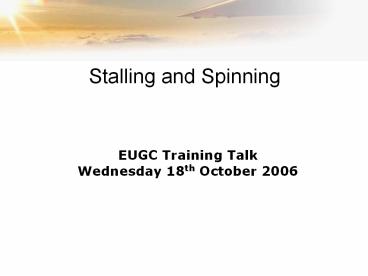EUGC Training Talk PowerPoint PPT Presentation
Title: EUGC Training Talk
1
Stalling and Spinning
- EUGC Training Talk
- Wednesday 18th October 2006
2
Horizontal fuselage datum
Chord
Span
Attitude
Flight path
3
Relative airflow
Flight path
Chord line
Horizontal fuselage datum
Angle of incidence
Angle of attack
4
- For AoA less than the critical angle lift is
proportional to AoA. - Beyond the critical angle lift reduces with AoA
and drag increases rapidly.
CL
AoA
5
(No Transcript)
6
- Stalling depends only on the angle of attack
exceeding the critical angle. - This can happen at any airspeed given a
sufficiently high load factor. - Load factor increased by turning, vertical
acceleration, winch launch. - Example in a 2G turn
- L1 ½?CLV12 L2 ½ ?CLV22 L2 2L1
- V2 V1v2
- So if the 1G stalling speed is 37kts, for
example, the stalling speed in a 2G turn will be
52kts.
7
Recovery
- Stall caused by too high an AoA.
- Therefore recovery is to reduce to AoA.
- Rate of acceleration/decrease of AoA depends on
attitude. - Therefore amount of forward movement required
depends on attitude. - Failure to lower nose sufficiently results
inlow/no acceleration risk of another stall.
8
Symptoms
- Attitude nose high
- Low airspeed
- Airflow noise
- Buffeting
- Changing effect of controls
- Stick position
- Elevator fails to raise the nose
9
Mushing Stall
10
Hammerhead Stall
11
Stall off a Launch Failure
12
Spinning
- Glider is asymmetrically stalled
- Pitching, rolling and yawing simultaneously
- Low airspeed
- High rate of descent
13
Unusual attitude Rapid rotation High rate of
yaw Rapid descent Low IAS Low and steady
G Laughter from back seat
14
Spin Recovery
- Full opposite rudder
- Centralise the ailerons
- Pause (not normally necessary in gliders)
- Move the stick forwards until the rotation stops
- Centralise the rudder
- Recover from the dive
PowerShow.com is a leading presentation sharing website. It has millions of presentations already uploaded and available with 1,000s more being uploaded by its users every day. Whatever your area of interest, here you’ll be able to find and view presentations you’ll love and possibly download. And, best of all, it is completely free and easy to use.
You might even have a presentation you’d like to share with others. If so, just upload it to PowerShow.com. We’ll convert it to an HTML5 slideshow that includes all the media types you’ve already added: audio, video, music, pictures, animations and transition effects. Then you can share it with your target audience as well as PowerShow.com’s millions of monthly visitors. And, again, it’s all free.
About the Developers
PowerShow.com is brought to you by CrystalGraphics, the award-winning developer and market-leading publisher of rich-media enhancement products for presentations. Our product offerings include millions of PowerPoint templates, diagrams, animated 3D characters and more.

